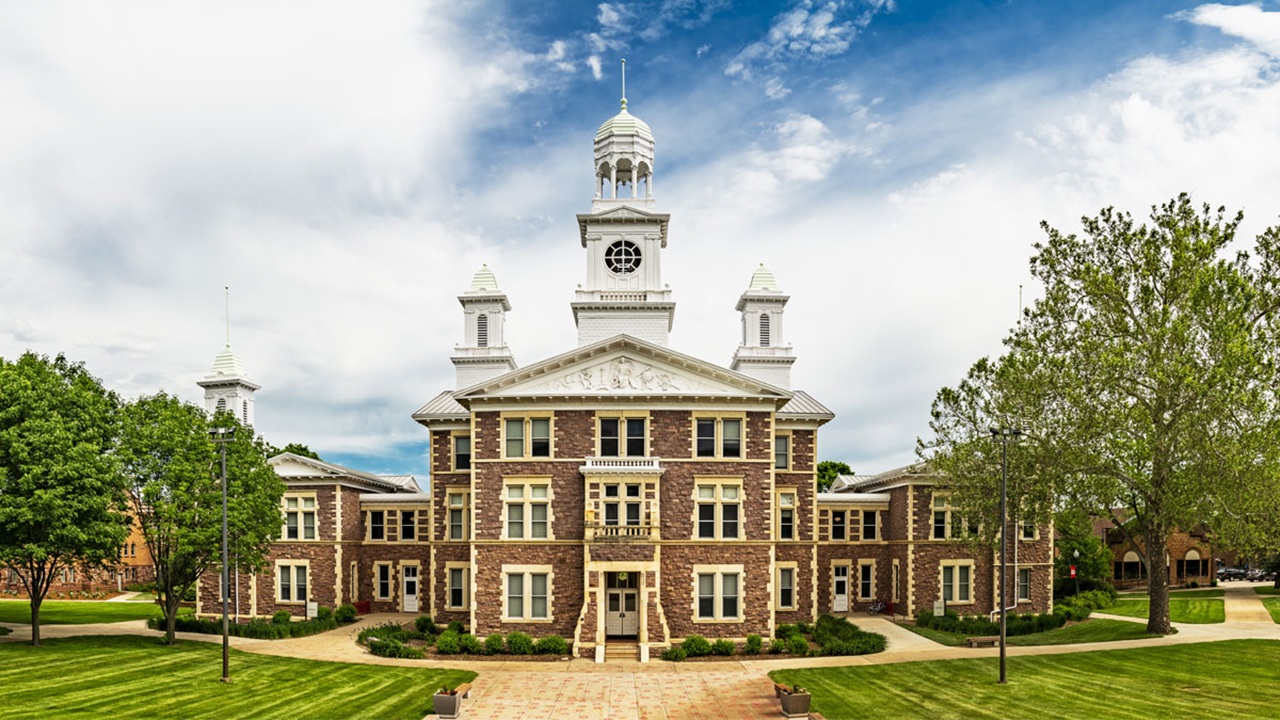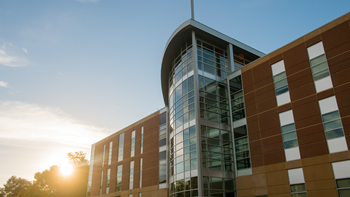
On June 22, 2018, Dr. Janet Lindemann, dean of medical student education, will retire from the University of South Dakota Sanford School of Medicine. Dr. Lindemann’s significant legacy at the medical school includes helping develop the Parry Center for Clinical Skills and Simulation, reorganizing the medical school’s course of study into a widely praised “Three Pillar” curriculum and leading the Liaison Committee on Medical Education (LCME), the national accreditation organization tasked with the weighty responsibility of assuring that graduates of U.S. medical schools are skilled and competent.
In early May a package was delivered to Dr. Janet Lindemann’s rural Sioux Falls home. Judging from the sender’s name, Lindemann knew what was inside.
“In 1984, long before I came to South Dakota,” began Lindemann’s explanation, “I was closely working with a patient in Wisconsin. This patient, a woman, was overweight and she’d become diabetic, and she was struggling with her diabetes. I implored her to lose weight, and she took my advice to heart. Her diabetes abated, and she was so grateful she began sending me gifts.”
The packages started arriving shortly after Lindemann had first counselled the patient. More than 30 years later, and following Lindemann from Wisconsin to South Dakota, the gifts keep arriving, one by one, year after year.
When Lindemann had first visited the patient at her home in 1984 she commented on the patient’s extensive collection of Charles Dickens village pieces, a veritable community of collectables modeling Dickens-era buildings, homes and community settings. The first gift Lindemann received was a Dickens collectable. Every gift since then has also been a Dickens piece. That patient, now in her 90s, is eternally appreciative for the personal and beneficial care she once received from a young physician. Lindemann understands that the aging woman is paring down her own collection in order to build Lindemann’s.

Today, Lindemann happily declares that her goal in life has been to serve others and to glorify her God through that service and work. “I was given such an opportunity in my profession and here at the medical school,” she explained. “This school has been a fantastic place to work, with so many other people here also dedicated to service, students and health care. Because of my national accreditation work I have been intimately exposed to many medical schools around the country, and there are many good ones, but this is the best one when it comes to caring about and educating its students.”
Lindemann’s journey to the University of South Dakota Sanford School of Medicine began in Milwaukee, Wisconsin, where she grew up as one of three children in a supportive, close-knit family. After graduating from Marquette University, in Milwaukee, she stayed put to attend the Medical College of Wisconsin. That was followed by a residency in family medicine. Dr. Lindemann was barely a year into her first, formal medical practice when she met the lady with the Dickens collection.
For six years Lindemann built a successful medical practice, and she cherished her patients and was committed to their care. She was a busy, board-certified family physician performing obstetrics, gynecology, pediatrics and internal and geriatric medicine. It was fulfilling work, more than work, really, but she also wanted to satisfy her interest in academics and add that to her role in health care. So she blended her medical practice with work at a medical institution as a clinical professor at the Medical College of Wisconsin. She steadily climbed the ranks at the medical college, advancing to associate professor and becoming an integral leader in the school’s addition of a rural medicine track. She also helped lead the school’s accreditation planning.
When an opportunity to work on similar and other topics in an even greater capacity arose at South Dakota’s only medical school she eagerly considered the prospect.
While in medical school Lindemann had met and married her husband, Larry, a dairy farmer from near Waukesha, Wisconsin, where she did her residency. During a stint in the military Larry had served at Minot Air Force Base in North Dakota, and he was enthusiastic about building a farm operation in the more open country of the Dakotas. With compatible dreams, they packed up their young family – two children – and left behind the wetter, more wooded environs of central Wisconsin.
In 1997 Lindemann joined the University of South Dakota’s medical school as an associate professor in the Department of Family Medicine and as co-director of the school’s Primary Care Ambulatory Program. She also set up a new clinical practice as a family practitioner in Sioux Falls. By 2001 she’d become the first full-time dean of medical student education at the medical school.
“She is a rare individual whose skil, integrity and dedication have shaped and improved medical education at the USD Sanford School of Medicine and throughout the United States. Her legacy is both broad and deep.”
—Dr. Mary Nettleman, dean of the school of medicine
The assignments she tackled were formidable and highly consequential. Medical school dean Dr. Rod Parry asked her to lead the effort to develop a simulation center in the Health Science Center, and Lindemann and Parry met with various constituencies to not only cultivate support but also to develop the type of programming that would best serve a variety of South Dakota health care interests. “Janet,” recalled Parry, “was able to determine the strengths and needs not only of the medical school but also of the state of South Dakota. She figured out how to merge those considerations and bring together a variety of constituencies to improve the medical school. Her role in developing the simulation center was essential.”
Lindemann had done considerable research about developing a simulation center for the medical school while earning an M.B.A. at the University of Sioux Falls. “The first plan for what we eventually named the Parry Center resulted from an idea I had while working on my M.B.A.,” Lindemann recalled. “For an M.B.A. project I developed a business plan to operate a sim center on the medical school campus.” That led to more serious planning and a focused effort alongside Dean Parry. Lindemann received her M.B.A. in 2009. The Parry Center for Clinical Skills and Simulation – now an invaluable aspect of medical student training – opened its doors in 2012.
Parry identified a second Lindemann achievement that dramatically advanced the medical school. “She played a major role, an integral role, in shaping and reforming the school’s curriculum,” Parry explained. “Curriculum reform was a major project the medical school realized under Janet’s leadership.”
The medical school had revised the curriculum used on the Yankton campus under Parry’s predecessor, Dr. Robert Talley, emphasizing ambulatory, problem-based and hands-on learning. Lindemann was asked to transition a similar curriculum to the entire school. “We’d formerly used a more traditional curriculum,” Lindemann explained, a process that provided two years of basic science followed by two years of clinical practice.
Lindemann and the committee she led changed that to what she titled a Three Pillar approach, shortening the two-year timeframe emphasizing the basic sciences to 18 months, and adding two sections of time – Pillars Two and Three – where clerkships and student exploration of personal options and health care in general are a focus. The Three Pillar curriculum is lauded by medical academics and health care officials across the nation.
Lindemann’s primary responsibility at the medical school has had her constantly monitoring the school’s courses. “As dean of medical student education I served as chair of the medical education committee,” she explained. “That committee’s work – reviewing every course every year – is vital, because our curriculum is at the heart of the institution.” That intensive level of scrutiny includes student and faculty feedback, and requires regular meetings by the committee. “Between the curriculum work I did in Wisconsin, and the medical education committee work I’ve done here,” Lindemann reported, “I have chaired 250 medical education committee meetings.”
Lindemann worked on accreditation issues while at the Medical College of Wisconsin, and she brought that experience and interest with her to South Dakota. “My work on accreditation, not only here at the medical school, but also working with the national accreditation body – the Liaison Committee on Medical Education (LCME) – has been remarkably rewarding,” she said. Lindemann led the medical school through several demanding accreditation processes, organizing the school’s preparations and assuring its readiness. The result: two stellar eight-year accreditations were achieved during the years Lindemann took a leadership role in the school’s accreditation activities.
On top of her duties at the medical school Lindemann embraced positions with the national LCME committee, including serving as chair of the group during the 2016-2017 school year. ”It was a huge honor to serve on the committee,” said Lindemann, noting that most of those serving on the committee were full deans from medical schools. Lindemann also participated in site visits to medical schools in the United States and Canada, evaluating those institutions as part of the accreditation process.
Lindemann’s leadership was exemplary, said Dr. Barbara Barzansky and Dr. Robert Hash of the LCME. “Her participation and leadership in the LCME has been instrumental in transitioning the LCME to the revised accreditation standards, and for establishing foundations for strategic planning for the LCME,” said Barzansky, committee secretariat. “Her collaborative style, extensive knowledge of the accreditation process, and leadership skills were highly effective in ensuring the continued success of the LCME,”’ she added. “Dr. Lindemann possesses a dedicated passion to ensure that medical schools in the United States and Canada provide the best medical education in the world,” said Hash, assistant LCME secretary at the American Medical Association.
Those who know her describe Lindemann’s irrepressibly happy, optimistic demeanor. But that characteristic has been tested.
Lindemann faced serious medical issues while battling cancer. Twice she witnessed her cancer go into remission, and the side effects leading to remission had surprising consequences.
In 2007 the school of medicine celebrated its 100th anniversary, and then-school Dean Rod Parry commissioned a piano piece to help celebrate the occasion. He asked Lindemann, a talented pianist, to perform that composition. Lindemann had long sought relaxation by playing her treasured grand piano, but as her cancer returned and treatments against it intensified she discovered that not only was she unable to play the piano as she once had, she was uncomfortable listening to piano music, long an enjoyable staple in her life. “Suddenly, I preferred listening to rock guitar,” she chuckled. “Instead of Chopin I had on Carlos Santana.”
“Janet’s special blend of insight and humor has made her a wonderful colleague and friend,” observed Dr. Mary Nettleman, dean of the school of medicine. “She is a rare individual whose skill, integrity and dedication have shaped and improved medical education at the USD Sanford School of Medicine and throughout the United States. Her legacy is both broad and deep. We wish her well. She will be deeply missed.”
Lindemann approaches retirement with her usual cheery outlook. “My husband and I have a place at the Missouri River, and we’ll spend more time there,” she reported. There are sprawling river bluffs, big boisterous skies and lots of trees to ponder from her river home, she said. “And there’s good fishing, too,” she declared, pointing to a photo of her hoisting a lunker walleye.
“I like the process of accomplishing things, and the process of working through a project,” Lindemann explained. “I don’t intend to stop being a doer, but in retirement I won’t feel pressured into doing anything.”




